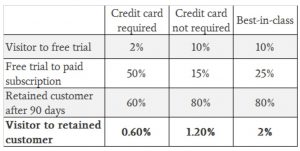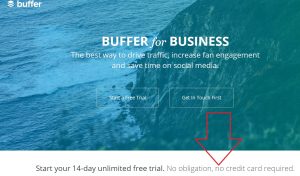6 Surprising Reasons why People Won’t Buy Your SaaS (and How to Boost Saas Sales)

I’ve been working with more than a dozen Software-As-A-Service companies so far and I have yet to see one that doesn’t have “boost SaaS sales” listed as a top priority. SaaS marketing is quite unpredictable sometimes: you’re doing everything right, from copywriting to marketing strategy, but people still won’t buy your SaaS.
With a market that may grow to $164.29 billion by 2022 according to Gartner, there’s no wonder that SaaS owners want bigger and bigger slices of it. But what happens when people say “no, thank you”? Why do they say it? Will they buy from your competitors or simply forego a similar solution altogether?
Let’s find out!
6 Surprising Reasons why People Won’t Buy Your SaaS (and How to Boost Saas Sales)
-
They Have Security Concerns
It’s safe to assume that your typical SaaS user is digitally literate. Aside their expertise with digital products, they also stay up to date with the news in the digital/social/software news.
In a world where not a day goes by without a cyber-attack, can you blame them for being cautious? Even though trust in cloud security is rising, there are still valid concerns to be addressed.
And, if you want to boost SaaS sales, it’s your job to address every single one of those concerns.
Here’s what you can do:
- Be transparent: you won’t be able to boost SaaS sales if you hide facts. If your software has any vulnerabilities, let your clients know that you are on top of them.
- Explain how your SaaS works: remember that your clients are tech-savvy, so you can be sure they’ll understand your explanations. You don’t have to give away trade secrets or snippets of code. Just explain why your architecture is safe.
- Statistics always help: share stats about how cloud security is improving (see above) and about how SaaS is safer and safer from every point of view.
- List your security benefits: from antivirus to brand protection and iron-clad hosting, list any added benefit that makes your SaaS secure.
-
You’re Not Solving a Problem
…for a specific customer. No good SaaS marketing strategy is complete without a very detailed buyer persona outline.
You need to know exactly who qualifies as a buyer if you want to boost SaaS sales. And your first task here is to identify your potential client’s pain point. Then explain how your SaaS solves it. BUT (and this is a big but!) it needs to be a real problem.
For instance, you won’t be able to sell a new social media management tool just because it has a different background color. You need to solve an actual problem that the likes of Sendible, Hootsuite, Buffer and so on don’t.
Here’s what you can do:
Revise your marketing strategy to include the right buyer persona or move on. That’s right! There’s no point in barking at the wrong tree. Even if your SaaS solves a real problem for some, it doesn’t mean everyone has that problem. Also, some people will be loyal to your competitors whatever you do.
-
They Dread the Commitment
The free trial is there to allow people to get to know your product. But this doesn’t mean certain people won’t hate the idea of having to pay you every single month.
Some might not even sign up for the free trial if your monthly fee is too high. Think about it as a shoe store: some will try on shoes they could never afford. Others won’t even give them a second look after they see the price tag.
Here’s what you can do:
Offer some satisfaction guarantee and/or social proof that your SaaS is worth the money. This is to convince those who are on the verge. Testimonials and case studies are your best friends here.
For the even more skeptical ones, remove the need for a credit card. According to this report, a “no strings attached” free trial policy can help you boost SaaS sales dramatically.
Photo via CoBloom.
Just look at what Buffer does. They added a simple phrase letting their potential users know that they can discontinue the service anytime. This is how much they trust the fact that you’ll fall in love with them.
4. They Don’t Trust You’ll Be Sticking Around
This is a major problem for every new SaaS. Learning the ins and outs of a new tool takes time, no matter how user-friendly your solution is.
So why should people spare time (and money) to learn how to use yours if they have no guarantees that you’ll stick around for the foreseeable future?
Most SaaS tools have “no more wasted time with X” among their strongest selling points. What they fail to convey is that the time investment for learning how to use said tool is also safe.
Here’s what you can do:
Use all your channels (from your blog to your SaaS’ social media profiles) to let potential users know you plan to stick around. This can be as simple as giving a few details about your future plan: features that you plan to add, shout outs to new employees, team expansion plans and so on.
Whatever shows your commitment to your SaaS solution should be out there, in plain sight. Also, you need to make sure that your commitment is also conveyed through extensive content marketing endeavors. Blog, tweet, create webinars, podcasts, case studies, white papers and so on. They don’t just help with SaaS lead generation, but also with convincing “almost-buyers” that you are here to stay.
-
You Don’t Offer a Free Trial
It’s the norm. Older statistics say that only 44% of SaaS companies offer a free trial. However, it is safe to assume that the numbers are on the rise.
Why?
Because free trials have proven to be efficient if you want to boost SaaS sales. People expect to have a chance to take your solution for a test drive before committing to it. And if your competitors do it, then you have no way around this.
Here’s what you can do:
This one’s pretty obvious: you must offer a free trial if you want to boost SaaS sales. The more successful free trials are those that last a month. However, SaaS companies like Socedo and Social Quant only offer 7-day and, respectively, 14-day free trials.
The reason is simple: their Twitter tools help you increase the number of relevant followers. But in a month of free trial, you can easily reach your target number of followers. Why bother paying for it afterwards?
-
You’re Being too Pushy
OK, people subscribed to your newsletter, maybe even tried your free trial, but they won’t convert into long-term users. So your plan is to bombard them with tons of emails and social media ads?
Wrong!
When people feel you’re desperate, they start thinking something may be wrong with you. Remember: your goal as a SaaS provider is to help them solve problems and manage their time better, not to be a time-consuming nuisance.
You’ll never boost SaaS sales this way.
Here’s what you can do:
- Create a reasonable email sequence. I wrote more about effective email campaigns here.
- Offer relevant, informational content instead of ads: case studies, webinars and white papers are always great.
- Make the user feel in control: inbound sales should never feel like sales. Your prospects should feel like you’re only there to help them make the best decision – even if this doesn’t include you.
Want to boost SaaS sales in a sustainable manner? We can help!



